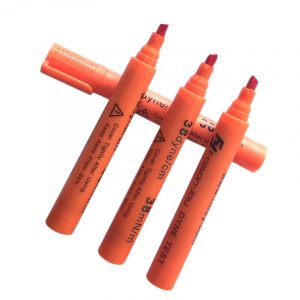Determination method of Dyne pen test
Dyne pen is a tool commonly used in surface tension testing to evaluate the wettability and coating properties of material surfaces. The following is the general determination method of the Dyne pen test:
Preparation:
Make sure the surface being tested is clean, dry and free of oil.
The dyne pens were calibrated according to their marked surface tension values to ensure their accuracy.
Determination method of Dyne pen test
Take a test:
If the ink of the pen wets the entire surface uniformly and continuously without breaking points or stagnation, it means that the surface has sufficient wettability and the surface tension is higher than or equal to the calibration value of the pen.
If the ink of the dyne pen breaks, stagnates or forms beads on the surface, it indicates that the surface is poorly wettable and the surface tension is lower than the calibration value of the dyne pen.
Touch the dyne pen gently perpendicular to the surface under test and quickly move it over the surface.
Observe the behavior of the dyne pen on the surface:
Determination method of Dyne pen test
The judgment result:
If the calibration value of the dyne pen is 38 dyn/cm and a break point or stagnation is formed on the tested surface, the surface tension is below 38 dyn/cm.
The surface tension is higher than or equal to 38 dyn/cm if the dyne pen is calibrated to 38 dyn/cm and uniformly wetted on the tested surface without forming breakpoints or stagnation.
Based on the comparison of the behavior of the dyne pen and the calibration values, the following conclusions can be drawn:

Tip: The results of the Dyne pen test only provide a relative assessment of the surface tension and do not give an accurate value of the surface tension. In addition, the test results may also be affected by other factors, such as surface roughness, surface treatment, temperature, etc. Therefore, other factors should be taken into account and used as a reference for surface wettability and coating performance when conducting the dyne pen test.
